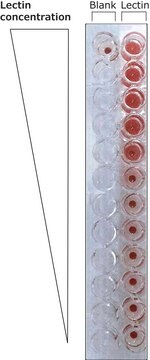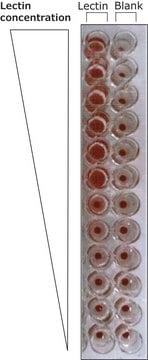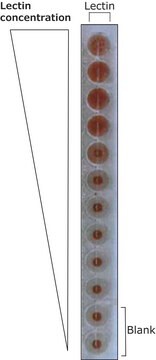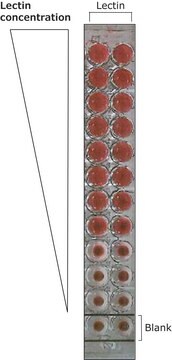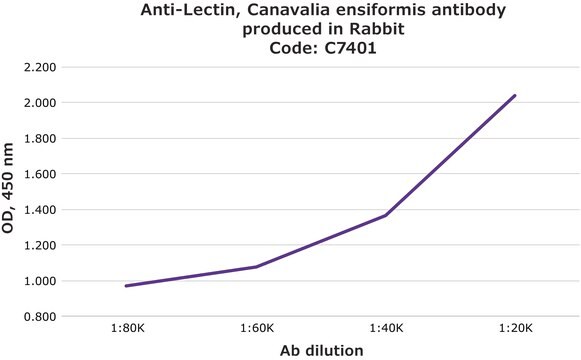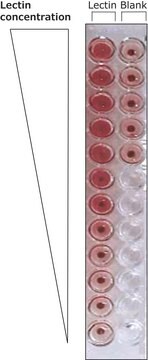T4144
Anti-Lectin, Triticum vulgaris antibody produced in rabbit
fractionated antiserum, lyophilized powder
Sinónimos:
Anti-WGA, Anti-Wheat germ lectin
Iniciar sesiónpara Ver la Fijación de precios por contrato y de la organización
About This Item
Productos recomendados
origen biológico
rabbit
Nivel de calidad
conjugado
unconjugated
forma del anticuerpo
fractionated antiserum
tipo de anticuerpo
primary antibodies
clon
polyclonal
Formulario
lyophilized powder
reactividad de especies
Triticum vulgaris
envase
vial of 2 mL
técnicas
indirect ELISA: 1:50,000
temp. de almacenamiento
2-8°C
modificación del objetivo postraduccional
unmodified
Descripción general
Wheat germ lectin, also known as wheat germ agglutinin (WGA), has a molecular weight of 36 kDa. It shows affinity to 1,4-N-acetylglucosamine (GlcNAc) oligomers and is useful in studying surface components of C. neoformans.
Inmunógeno
Wheat Germ lectin (WGA)
Aplicación
Anti-Lectin, Triticum vulgaris antibody produced in rabbit has been used in
- immunolabeling experiments
- immunohistochemistry
- immunocytochemistry
Anti-Lectin, Triticum vulgaris antibody produced in rabbit has been used in immunohistochemistry and immunocytochemistry.
Acciones bioquímicas o fisiológicas
Wheat germ agglutinin is a lectin isolated from Triticum vulgaris that has affinity for chitin oligosaccharides, peptidoglycans and glycolipids via sialic acid residues. It is not specific for human blood groups and has been identified as antagonists of botulinum and tetanus toxins.
Descripción de destino
Lectins are highly specific carbohydrate binding proteins useful in carbohydrate and cell membrane studies, as well as cell agglutination and typing techniques.
Forma física
Lyophilized from 0.01 M phosphate buffered saline, pH 7.2
Reconstitución
Reconstitute with 2 ml deionized water.
Cláusula de descargo de responsabilidad
Unless otherwise stated in our catalog or other company documentation accompanying the product(s), our products are intended for research use only and are not to be used for any other purpose, which includes but is not limited to, unauthorized commercial uses, in vitro diagnostic uses, ex vivo or in vivo therapeutic uses or any type of consumption or application to humans or animals.
¿No encuentra el producto adecuado?
Pruebe nuestro Herramienta de selección de productos.
Código de clase de almacenamiento
12 - Non Combustible Liquids
Clase de riesgo para el agua (WGK)
WGK 3
Punto de inflamabilidad (°F)
Not applicable
Punto de inflamabilidad (°C)
Not applicable
Equipo de protección personal
Eyeshields, Gloves, type N95 (US)
Elija entre una de las versiones más recientes:
¿Ya tiene este producto?
Encuentre la documentación para los productos que ha comprado recientemente en la Biblioteca de documentos.
João Manuel Braz et al.
The Journal of comparative neurology, 507(6), 1990-2003 (2008-02-15)
Despite the evidence for a significant contribution of brainstem serotonergic (5HT) systems to the control of spinal cord "pain" transmission neurons, attention has turned recently to the influence of nonserotonergic neurons, including the facilitatory and inhibitory controls that originate from
Detection of local and remote cellular damage caused by spinal cord and peripheral nerve injury using a heat shock signaling reporter system
Hashimoto-Torii K, et al.
IBRO reports, 91-98 (2018)
N Bakry et al.
The Journal of pharmacology and experimental therapeutics, 258(3), 830-836 (1991-09-01)
Lectins from Anguilla anguilla, Artocarpus integrifolia, Canavalia ensiformis, Datora stramonium, Glycine max, Limax flavus, Ricinus communis and Triticum vulgaris were tested for their abilities to antagonize the binding of botulinum neurotoxin and tetanus toxin to rat brain membranes and to
Amygdala projections to the lateral bed nucleus of the stria terminalis in the macaque: comparison with ventral striatal afferents
decamp DM and Fudge JL
The Journal of Comparative Neurology, 521, 3191-3216 (2013)
Detection of local and remote cellular damage caused by spinal cord and peripheral nerve injury using a heat shock signaling reporter system
Hashimoto-Torii K, et al.
IBRO reports, 5, 91-98 (2018)
Nuestro equipo de científicos tiene experiencia en todas las áreas de investigación: Ciencias de la vida, Ciencia de los materiales, Síntesis química, Cromatografía, Analítica y muchas otras.
Póngase en contacto con el Servicio técnico
